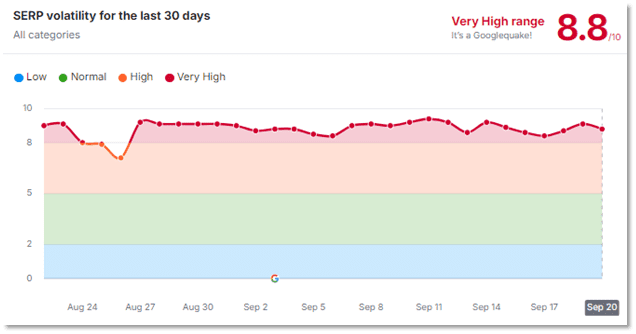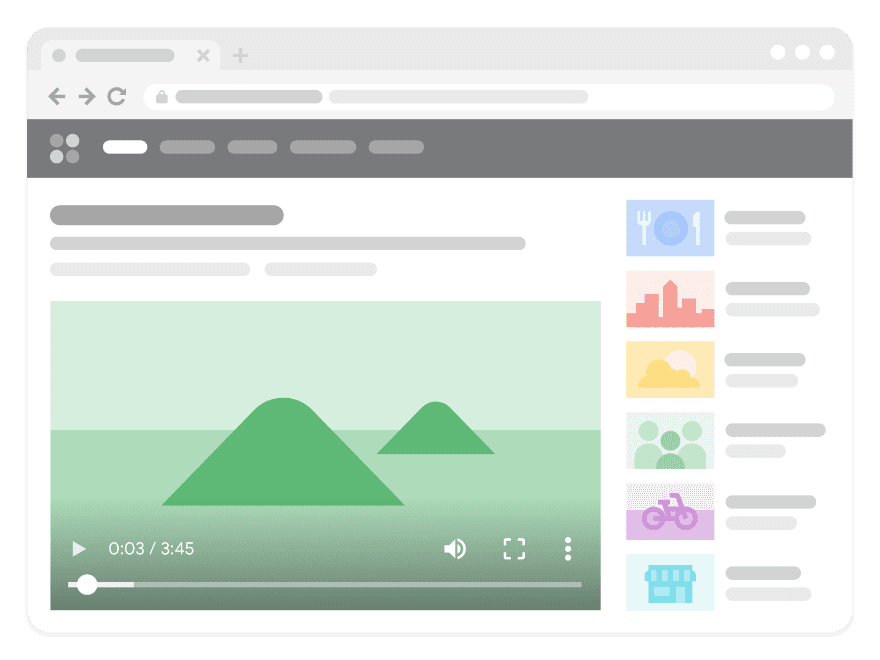Welcome to our September 2024 SEO News Recap! This month, we cover the August 2024 core algorithm update, AI overviews, automated SEO auditing tools, organic traffic fluctuations, and more. Also, be sure to check out our latest installment of “ROI Answers” at the bottom of this article to find answers to commonly asked SEO questions.
Jump to each September 2024 SEO News Recap topic using the links below:
- The August 2024 Core Update Is Complete
- Google Updated its Video SEO Guidelines
- AI Overviews and Top Search Results Overlap More
- Google: Beware of Advice from Automated SEO Auditing Tools
- John Mueller Reminds Us Not All Traffic Fluctuations Are Catastrophic
- ICYMI: Recent SEO Blog Posts
- ROI Answers: SEO FAQ of the Month
The August 2024 Core Update Is Complete
Taking 19 days to roll out, Google’s August 2024 Core Algorithm Update was completed on Tuesday, September 3rd. The update finished much faster than the expected four weeks that Google predicted. However, ranking volatility didn’t end with the update. Tools like the SEMrush Sensor (screenshot below) show very high SERP volatility for most industries even now.

A few days after the update finished, Search Engine Roundtable’s Barry Schwartz interviewed Google Search Liaison Danny Sullivan about the state of Google Search quality. Here are a few of the conversation’s highlights:
- Google does smaller updates about 5,000 times per year, but it occasionally needs to implement much bigger core updates. Those are the updates we notice.
- The August core update was, at least partially, aimed at doing “better with great ‘smaller independent sites.” This seems to be in answer to complaints those smaller publishers have had since last year’s helpful content update.
- Future updates will continue to attempt improvements with respect to rewarding good content regardless of the website’s size.
- The systems affected by core updates are tested before the update is officially rolled out. So, the volatility during updates is not a result of “corrections” happening mid-process. They are part of the process of multiple systems changing across many data centers.
- Sullivan really did read the feedback forms that were submitted after the March 2024 update, and he took it to the engineering team. Some of that feedback factored into the August core update and some will be part of future updates.
- The Reviews system now updates regularly, which could be one reason for the continuously high ranking volatility.
We could list all the talking points from the interview, but it’s a good idea to read it for yourself. It’s one of the longer interviews SE Roundtable has published and well worth the time.
Google Updated its Video SEO Guidelines
Lately, we’ve noticed that it feels much more difficult to get embedded videos indexed by Google – and ROI clients aren’t the only ones experiencing this. In what seems like an effort to clarify its guidelines, Google has updated its Video SEO Best Practices documentation. Here are the two major areas of change:
Indexing Criteria
Videos must meet the following criteria to be eligible for video features (i.e. video thumbnails in search results, featured videos, video mode, and Discover):
- The video’s watch page must be indexed and performing well in Search before the video itself is considered for indexing.
- The video must be embedded on its watch page. It can’t be hidden behind other elements (like paywalls or sign-in requirements).
- The video must have a valid thumbnail (requirements include accepted file formats, minimum size, and accessibility for Googlebot) available at a stable URL.
Watch Pages
These URLs must be very overt in their purpose, which is “to show users a single video.” Here are a few tips for creating dedicated watch pages:
- The embedded video should be the most prominent element on the page – video, episode, and clip landing pages are examples of watch pages.
- Don’t add a lot of text to your watch pages, or risk losing out on the classification. Blog posts with video elements, 360 videos on product pages, and pages listing multiple videos of equal prominence are not as likely to be indexed as watch pages.
- Create unique page titles and descriptions for each video. ROI Tip: Include the word “video” in your page title to make it even more obvious.
Google shared an illustration of an ideal watch page format for reference:

AI Overviews and Top Search Results Overlap More
When Google first launched Search Generative Experience, the precursor to AI Overviews, about 94% of the sources cited for it were outside of the top 10 organic positions. Recent studies show that the percentage has decreased quite a bit. One, published by Mark Traphagen of seoClarity in August, stated that AI Overviews now matches with sources in the top 10 almost 99% of the time. However, a different study released in September by Authoritas states the overlap happens 46% of the time.
Why such a large gap between the two? Researchers often count things differently from each other. Looking at an ever-changing feature on Google on separate dates can result in vastly different datasets. One takeaway that is certain is that Google is using pages ranking in the top 10 organic results much more often than it was just a few months ago.
Google: Beware of Advice from Automated SEO Auditing Tools
In August’s SEO Office Hours, a user asked if an automated SEO auditing tool’s recommendations matter for SEO, especially since they aren’t stated in Google’s Search Central documentation. Google’s Martin Splitt answered that many of those tools look at parameters that have little to do with SEO, like text-to-code ratio. “That’s not a thing,” he said.
Google creates documentation in Search Central, the Quality Raters Guidelines, etc., to set a baseline for how to optimize a website so that Google can understand it and index pages it deems worthwhile. Google doesn’t tell us everything, though. Most of what is considered SEO best practices are things that SEOs have experimented with and found to work on some level. However, Google’s technology and algorithms are always changing, so older practices that helped a decade ago may be obsolete now. Automated tools are often programmed based on older ideas, so take their recommendations with a grain of salt – or better yet, ask the ROI Revolution SEO team for our expert advice!
John Mueller Reminds Us Not All Traffic Fluctuations Are Catastrophic
In a recent Reddit thread, a user asked why they saw big fluctuations in impressions and clicks in their Google Search Console data. Google’s John Mueller put the data into perspective, quoting the “strong law of small numbers”: There aren’t enough small numbers to meet the many demands made of them.
The screenshot of the GSC graph the users shared shows a range of zero to six clicks on the left side. A difference of just a click or two in a day can make the trend line look like it’s shifting dramatically up or down. The reality is that it’s not a big change. Larger sites are less likely to see such large dips and spikes because they have more data to work with.
It’s important to keep in mind that traffic fluctuations are a normal part of site ownership. Contributors include seasonality, news cycles, ranking volatility, and overall search trends. The time for concern is when you see a sustained decline in traffic and clicks because that may mean Google has changed the way it views your website.
ICYMI: Other Recent SEO Blog Posts
Our Top 8 Takeaways from the Google Search API “Leak”
ROI Answers: YouTube SEO Questions
We can’t take all the credit for this segment. Barry Schwartz interviewed the YouTube Liaison, asking a number of great YouTube SEO questions, and we’ve summarized the answers to save you some time!
Q: Does the algorithm care what category you choose for your video?
A: It’s a minor consideration, but we might look at this to figure out what your video is about.
Q: What’s the secret to pleasing the algorithm?
A: Follow the audience. Use the audience insights to figure out which videos your audience likes best and make more videos like those.
Q: How important are keyword tags (added in the uploader)?
A: Less important than the title and description, but we recommend adding common misspellings of your channel name and tags related to the video topic.
Q: Do hashtags matter?
A: Again, less than the title and description, but they can be useful for hopping on trends.
Q: Does cadence or consistency matter for video performance?
A: Maybe, but in unexpected ways. Posting on a consistent schedule can encourage regular viewership by loyal followers. Also, keeping to a schedule keeps you accountable for consistently creating and uploading content. This can help you improve your skills and content quality.
Q: Does the description matter?
A: Yes, your description should be reflective of what your video is about to help the algorithm serve it to the right audiences. We don’t recommend keyword stuffing.
Q: Why do some videos take days (or more) to take off?
A: This happens a lot with helpful content (like how-tos or recipes), where people are searching for a specific topic, but don’t necessarily engage with more videos from your channel. Your core audience doesn’t necessarily engage with the video right away, so being found by the right users takes some time.
Q: Does low retention on embedded videos (external traffic sources) matter to the YouTube algorithm?
A: No, we’re not looking at external traffic for this.
Q: Does the file name you choose matter to the algorithm?
A: No, but always put a good title on your video.
Q: Does putting long-form videos, Shorts, and lives on the same channel confuse the algorithm?
A: Not necessarily; it’s more about creating videos that are all meant for the same audience on one channel.
Q: Does checking ‘Paid Promotions’ on your video matter to the algorithm?
A: No, we don’t look at this when we decide what to recommend to each user.






